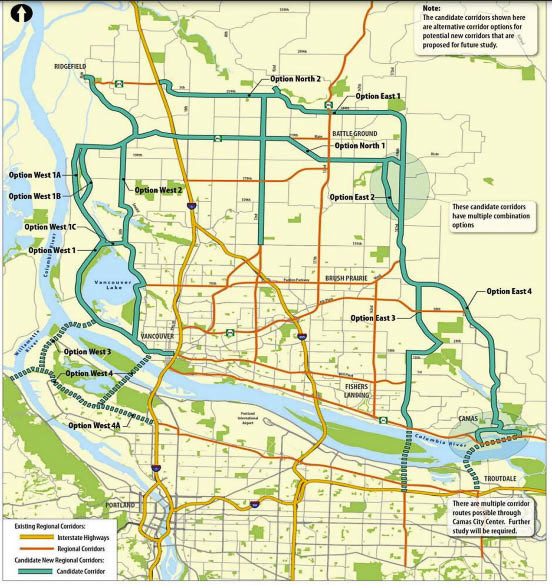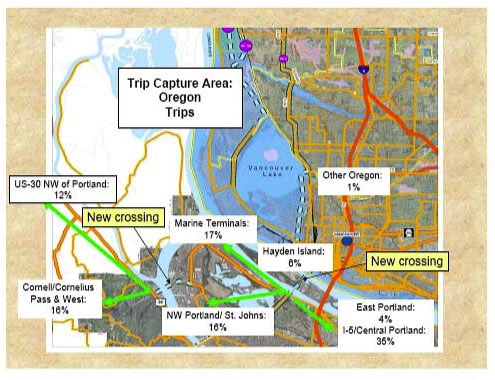Planning for new corridors and bridges are considered behind schedule as County Council members start their own planning process hoping others will join the effort
Members of the Clark County Council approved a resolution indicating their desire to move forward with planning for “at least” a third transportation corridor. “A Third Corridor is Integral to the IBRP Discussion” was the title to a 5-page discussion document provided by Councilor Karen Bowerman.
“It was my pleasure to work for what we Clark County residents need, and that is legitimate relief of traffic congestion,” Bowerman said in an email to CCT. “The planning horizon is long and challenging. But starting now, we will have fewer missteps of allowing the construction of roads and housing and businesses where the new corridors would be.”
Where those corridors will be is “unknown at this time,” Bowerman said in her opening remarks to the council. She thanked both citizens and her fellow councilors for input and suggestions following recent discussions. “It is better because of your input,” she said.
The council began deliberations back in August regarding their position and input on the Interstate Bridge Replacement Program (IBRP). Their recommendations came a month after members of the Vancouver City Council made their desires known. The county focus was on improving traffic congestion and the movement of freight. The County Council members rejected tolling as a means to pay for the project, and rejected light rail as a form of mass transit. The council members said tolls “would have a negative impact on all Clark County residents, particularly those with low income.”
The council continues addressing transportation issues and needs, looking into the future regarding what will be needed to reduce traffic congestion. “It has to start somewhere,” said Chair Eileen Quiring O’Brien at their Oct. 27 Council Time extensive discussion. She noted this is not trying to stop the current bridge replacement effort, but trying to take a leadership role in moving forward on new corridors.

Bowerman began the discussion on the resolution this morning by referencing the 2008 RTC Visioning Study. “It provided a basis on which we realized that there are alternative sites for a third and fourth corridor that might be built,” she said. The council is not advocating for any specific locations, but note that many things have changed in the ensuing 13 years.
It was noted that planning for additional corridors is behind schedule “because no one else is making the effort,” Medvigy said. Traffic congestion has been getting worse and it will only continue to get worse.
The councilors know planning is a long process so they want to start the conversations now, in part to identify potential areas in Clark County and ensure land can potentially be set aside, rather than have new development preclude logical corridor locations. They included mention of the Growth Management Act (GMA) and involving all other facets of county planning staff.
The councilors also hope the Southwest Washington Regional Transportation Council (RTC) will marshal its resources and join in the effort, in addition to the Washington State Department of Transportation (WSDOT). Additionally, they hope other jurisdictions including the various cities around the region will join in the effort. They ultimately look forward to Oregon’s various transportation and planning agencies joining in the planning and discussions, including Metro and the Oregon Department of Transportation (ODOT).
This discussion document began with the following.
The IBRP team is likely justified in saying there is no third bridge in its regional transportation plans, and therefore they cannot consider a third bridge option. Thus, this discussion will lead to a resolution that advocates for a third bridge in the regional transportation plans.
Given Portland’s reluctance to widen the I-5 significantly, Clark County Council supports repairing or replacing the I-5 bridge for traffic and seismic safety while maintaining all existing I5 lanes for auto traffic and simultaneously planning now for construction of at least a third corridor across the Columbia for auto traffic. If we kept only the I-5 and I-205 corridors that we currently have, then the entire corridors would need to be widened, including the Rose Quarter area. However, we know that Portland does not want additional lanes at the Rose Quarter, and certainly not ten lanes in each direction at the Rose Quarter by 2060 as some planners suggested, making the building of a third corridor now and planning for a fourth bridge critical.
Some allege the failure to include new bridges and transportation corridors has been intentional in order to keep the focus on replacing the Interstate Bridge. At Tuesday’s council meeting, Medvigy shared “in the RTC and ICC and other entities, they didn’t want to say anything different than simply replacing the I-5 bridge because they feared it would somehow submarine it, the current project.”
The councilors are not seeking to derail the current effort regarding the Interstate Bridge, but to begin long-overdue planning for new transportation corridors.
“Metro, ODOT, and the RTC would be a great center of gravity in moving towards the next steps,” Medvigy said. “Quite frankly, with more than a decade that’s now passed, we are so far behind in planning for these rights of way and where they could go and where they should go.”
New transportation corridors were identified long before the 2008 RTC Visioning Study. In a July 2019 document to the RTC Board, Executive Director Matt Ransom said: “The Vision Study was viewed as merely an initial step in the necessary integrated land use and transportation planning process. The study attempted to examine a single long term transportation/land use outcome.”
In the 1970’s, numerous government agency studies identified the need for new corridors and bridges. There was a plan to build a “ring road” around the Portland metro area, which started with the I-205 corridor serving as the eastern half of that ring road bypass. Maps showed the completion of the western half by 1990.
The Visioning Study forecasted that by 2050, both the I-5 and I-205 corridors would have over 150,000 daily vehicle trips. Furthermore, SR-14 would have between 50,000 and 150,000 trips.
“I think more work clearly needs to be done than what’s encompassed in this resolution,” said Councilor Julie Olson. She voted in favor of the resolution but seemed to express some reservations with some of the details within the resolution.
“We have known for over a decade that resolving for a third bridge across the Columbia River between Clark County and Oregon must be a commitment made now because planning will be long-term,” Bowerman shared in her email.
“Now has arrived!” she said. “Much is to be done in figuring out the best location for the third corridor and integrating its map into the Clark County Growth Management Act comprehensive plan update and our neighbors’ long-term transportation planning.”
The discussion document noted transportation architect Kevin Peterson scrutinized Columbia River Crossing (CRC) traffic project data which came from two Washington studies between 2000 and 2007. He identified that by 2060, there would be the need for nine lanes in each direction on the I-5 corridor and eight lanes in each direction on the I-205 corridor. That indicates 17 total lanes would be needed across the Columbia River just 40 years from now. There are seven today.
A question for regional planners: Do we want all those vehicles to use only two existing transportation corridors? It would seem to make sense to spread the traffic flow across the river among multiple transportation corridors, each serving the needs of different communities.
Portland has a dozen bridges across the Willamette River, over about a 12-mile area. Each serves different communities, and spreads the transportation burden among many smaller transportation corridors. One can only imagine the traffic nightmare if Portland had only two bridges across the Willamette River.
Quiring-O’Brien noted that Medvigy has been bringing up the issue for many years at the RTC Board, where she also serves. She noted the lack of support there, but said “It has to start somewhere,” in supporting this formal resolution.
Councilor Temple Lentz agreed with the concept of getting all the parties together for starting the discussion. Yet, she voted against the resolution in the end. She believed the resolution simply “asks someone else to do something”. “That’s largely what this resolution does,” she said.
Lentz said the resolution “fails to demonstrate even a rudimentary understanding of land use and collaboration that would be required to take something like this on.”
The councilors noted the Portland metropolitan area has two significant bottlenecks which affect Clark County traffic. One is the two-lane section of I-5 at the Rose Quarter. The other is US 26 and the three-lane Vista Ridge Tunnel connecting downtown Portland with Beaverton and Hillsboro, which serve Oregon’s two largest private employers (Intel and Nike). A western bypass could get around both of these bottlenecks.

In discussing a westside corridor, the council noted the benefits of additional corridors removing traffic from either I-5 or I-205. Each proposed corridor has been studied in detail, with numbers showing usage and relief of traffic congestion.
For example, the RTC Visioning Study “indicates that the Westside corridor options would carry between 38,000 and 46,000 vehicles per day across the Columbia River. If 100 percent of those were round trip commuters to Oregon, that could equal 76,000 to 92,000 crossings that do NOT use the Interstate Bridge.”
The council offered some additional perspective at the end of their talking points paper.
A question that has been bantered about since a 2006 email by Oregon’s Federal Highway Administrator, David O. Cox is the order in which the region should tackle its multiple issues. Cox asked whether “we try for the easier (and less expensive) widening of I-205 first? Maybe, but that might reduce the perceived need for an improved I-5 corridor? Should we try for the 3rd bridge first to improve the connection between the Ports with a new “freight” corridor? Maybe, but that might be seen as a substitute for widening I-205 and improving the I-5 corridor.” What we have settled on at this time is trying to get the most challenging project, the I-5 bridge replacement underway first.
However, by Feb. 16, 2012 an additional issue was memorialized when an Oregon Supreme Court Judge stated about the Columbia River Crossing (CRC): “The massive Interstate 5 bridge and freeway project is a ‘political necessity’ to persuade Clark County residents to accept something they previously didn’t want—a MAX light-rail line from Portland to Vancouver.” He wrote in the opinion that the 10-lane freeway bridge and new interchanges—was put forward to get Clark County to agree to the light-rail line. The discussion continues today on what type of public transit will be part of the I-5 replacement, ranging from light rail to bus rapid transit.
The final vote was 4 to 1 in favor of the resolution. Citizens will likely be eager to see if other communities and government agencies join their effort to resume the planning for new, third and fourth transportation corridors and bridges across the Columbia River.




